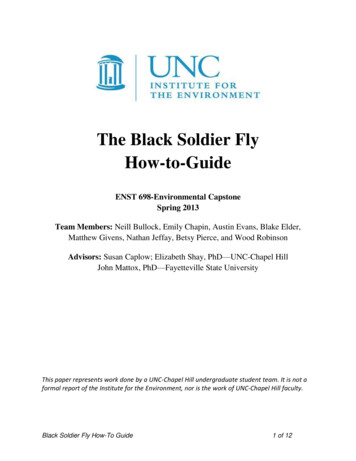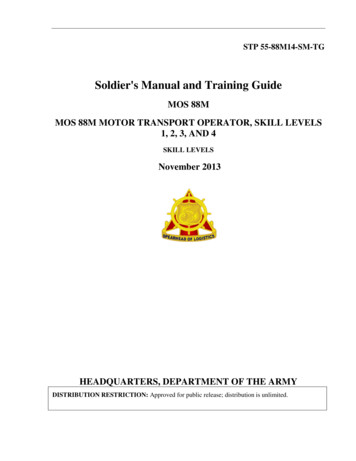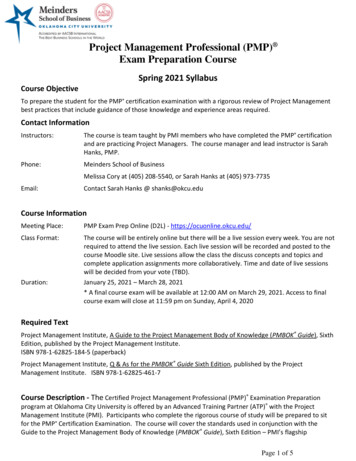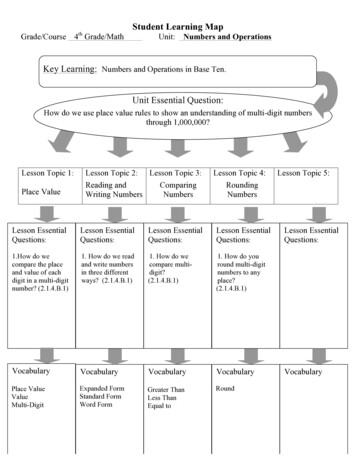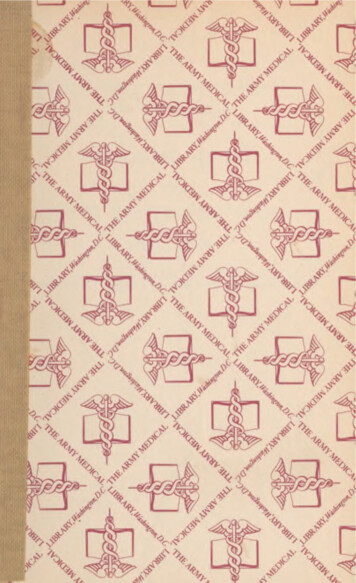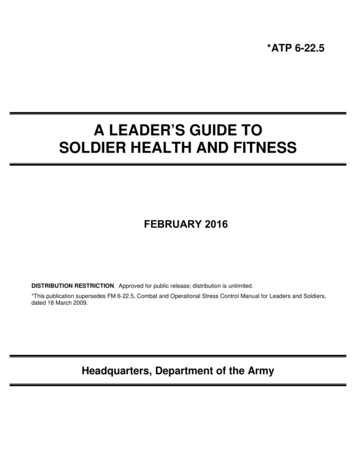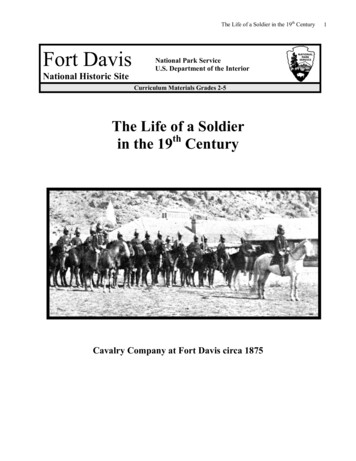
Transcription
The Life of a Soldier in the 19th CenturyFort DavisNational Historic SiteNational Park ServiceU.S. Department of the InteriorCurriculum Materials Grades 2-5The Life of a Soldierin the 19th CenturyCavalry Company at Fort Davis circa 18751
The Life of a Soldier in the 19th CenturyFort DavisNational Historic SiteCurriculum Materials Grades 2-52National Park ServiceU.S. Department of the InteriorTeacher Notes: Life of a Soldier in the 19th CenturyTopic: Life of a Soldier in the 19th CenturyStandards and Objectives:Grade 2Social Studies113.4 -17,18,19Language Arts110.4 - 3,4,8,9,13, 14,20Grade 3Social Studies113.5 -16,17,18Language Arts110.5 - 3,4,9,13,14,20Grade 4Social Studies113.6 -22,23,24Language Arts110.6 -4,5,9,10,11,13,15,21Grade 5Social Studies113.7 - 4,5,25,26,27Language Arts110.7 - 4,5,9,10,11,13,15,21Materials Needed:Copies of soldier information sheets: What Was It Like to be a Soldier Back Then? AndBeing a Soldier in the U.S. Army: Listening to the Bugle, as well as worksheetsInterview A Soldier, Soldiers, and Bugle call sheetStrips for Memory, pre-cut and in envelopes to keep them straightCopies of Vocabulary Drill—Military Words instructions; file folders for the VocabularyDrill game; one copy of the Vocabulary game words for each groupOptional: mail a blank CD or cassette to Fort Davis NHS and the staff will send you at nocost an audio copy of the bugle calls played at the fort.Optional: books that show pictures of soldiers from the late 19th centuryOptional: order from Fort Davis NHS a copy of the 30-minute video on the history ofFort Davis (cost 19.95 less 20% teacher discount shipping)Lesson Activity:Students read information sheets about a soldier’s life as a whole class, in small groups, or individually.If students know soldiers today or are familiar with military operations, they can add to the discussioncomparing how things are different or similar for soldiers today.Activities and Projects:* MemoryDirections for teacher: Cut apart the sentence strips about soldiers and put in an envelope. Five students sit in a circle to form a group and receive an envelope. Each student has different sentence fact from the set. Students should not let anyone see thesentence they are holding. One student starts by reading his or her sentence. The student sitting to the left repeats it and thenreads his or her sentence. Continue around the circle. Each student repeats the sentences thathave been said before, then adds the new one. When students have played with several different sets of sentences, have them go back to theirseats and write a paragraph telling things they learned about a soldier’s life. They can also drawpictures.
The Life of a Soldier in the 19th Century3* Vocabulary Drill—Military WordsStudents do not need to know the meanings beforehand. They will learn some by playing the game.Divide the class into groups of three. Pass out one set of the military word cards, which have been cutapart, to each group of three students. The answer sheets should be put into a file folder for the Officer tohold during the game.* Interview a SoldierGive each pair of students a copy of one of the information sheets about soldiers. If time is limited to dothis activity, tell students it will be a very short interview, and instruct them as to how many of each typeof question to ask. For example, 2 closed questions, 1 open, and 1 probe.
The Life of a Soldier in the 19th Century4Cavalry Company at Fort Davis, circa 1875FORT DAVIS RETREAT PARADE SOUND PROGRAMPlays daily at 11:00 a.m., 2:00 p.m., and 4:00 p.m.Retreat Parade was a military ritual that may have appeared out of place on the dusty frontier. Despite the grandappearance, Retreat was just another part of a soldier’s routine. The ceremony served a dual purpose—it was partof the ever-present discipline of the enlisted man, and it provided an opportunity for roll call and inspection. Forthe soldier, it marked the end of yet another day filled with drills and work details like hauling water, choppingwood, and caring for government stock.Let us journey back in time to a late summer day in 1875. The low light of the setting sun casts shadows across theparade ground, where officers are inspecting companies of the 10th U.S. Cavalry and the 25th U.S. Infantry in frontof the row of barracks. The soldiers are in full dress uniform, their polished brass insignia glistening in thesunlight. Also present is the 25th U.S. Infantry Regimental Band, ready to strike a note upon completion ofinspection of the soldiers. The evening Retreat Parade is about to begin.Along officers’ row, some of the ladies and children turn out to watch the martial proceedings from their shadedverandas. All is quiet and the signal to commence is given Trumpets: “Assembly” and “Adjutant’s Call”The adjutant posts the guides then instructs company commanders to bring their companies to “parade rest.” Hethen commands the band to “sound off.”The band plays “Hail Columbia” as it marches the full length of the assembled soldiers and back to its originalposition.Trumpets: “Retreat”The evening gun is fired. Company commanders order their companies to “present arms.”Trumpets: “To the Colors”The flag is lowered, followed by the playing of “The Star Spangled Banner.” The soldiers stand in formation for
The Life of a Soldier in the 19th Century5review. The adjutant then receives reports from the first sergeants of all companies. After they are accounted for,the adjutant reads out the day’s general orders. He announces the death of former President Andrew Johnson andthe honors to be paid him by the garrison.Note: “The Star Spangled Banner,” with a different arrangement, was not adopted as the National Anthem until1931.Review the TroopsThe commanding officer commands the review to begin. The band, playing “The Young Recruit” followed by“Garryowen,” marches to front and center, then remains in place. The soldiers march twice around the paradeground, first at a cadence of 100 beats per minute and then at double time—165 beats per minute. After the soldiersarrive at their original position and the band finishes playing, the commanding officer instructs the adjutant todismiss the parade.Dismiss ParadeThe parade is dismissed; the band continues playing until the parade ground is cleared.The music and commands of the U.S. Army ceased to echo through the mountains when Fort Davis was abandonedin 1891. As you walk about the grounds of Fort Davis National Historic Site, look at the buildings through the eyesof the officers, enlisted men, wives, and children who made its history.This sound program was recorded in cooperation with the staff of the United States Army Artillery and MissileTraining Center, Fort Sill, Oklahoma in 1964. Music was played by the 77th and 97th Army Bands.Bugle CallsThe post commander held a wide range of authority in the conduct of the garrison. The daily schedule of buglecalls was one of his tools in regulating the activities of the soldiers. Although the schedule would vary from seasonto season, the routine generally did not. The result was a regimented lifestyle that centered around the bugle call asa measure of time.This schedule of calls is extracted from schedules used at Fort Davis during the 1870s and 1880s. They arepresented to help visitors envision Fort Davis as an active military post. Differences between the historic army timeschedule and this time schedule are noted in the description of the bugle calls.8:15 Assembly of TrumpetersThe first signal for the soldiers to awake from their blissful slumber, this call historicallysounded between 4:45 a.m. and 6:00 a.m., depending on the season.8:20 Reveille- Upon the last note of this call, the flag was raised, the morning gun was fired, and all menwere out of their bunks and getting dressed for morning roll call.8:25 Assembly- The men stood in formation outside their barracks for morning roll call.8:30 Stable Call- Soldiers in the cavalry put on their white canvas stable clothing and reported to the stablesto feed and groom their mounts. This was historically done right after morning roll call,about 6:15 a.m.8:45 Water Call- Cavalry troopers watered their horses.9:00 Mess Call- Breakfast usually consisted of bread and bacon, mush and molasses, or pancakes, andplenty of hot, black coffee. This signal ordinarily sounded between 6:30 a.m. and 7:00 a.m.9:30 Fatigue Call- Those soldiers assigned to a morning work party reported to their assignments for fresh airand physical exercise. Typical work details included building repair and construction,cleanup of the post grounds, gardening, cutting firewood, and hauling water.
The Life of a Soldier in the 19th Century9:40 Sick Call6- Soldiers who were ill reported to the hospital dispensary for examination by the surgeon.Those who were truly sick were given a dose of “quinine and pills” and excused from workfor the day. Army surgeons were always watchful for malingerers—those who fakedsickness to escape work.10:00 Assembly of Trumpetersand Dress Guard Mounting- This was the first call for “Guard Mount,” or the changing of the 24-hour guard detail.10:05 Assembly of Guard Details- Men assigned to guard duty assembled in front of their respective barracks.10:10 Adjutant’s Call- The guard details marched to the guard house where the Guard Mount ceremony tookplace. This historically took place around 8:00 a.m.10:30 Drill Call- Soldiers who were assigned to morning drill assembled.10:35 Assembly- Soldiers practiced battle formations and marching. New recruits learned more basic skills.11:00 Recall- Morning work parties ceased at the sound of this call.11:30 Recall- Morning drill ceased.11:45 First Sergeants’ Call- Company first sergeants reported to post headquarters with their “Morning Reports,” whichgave the number of their men sick, on guard duty, on drill or fatigue, or on specialassignment.12:00 Mess Call- Dinner was the main meal of the day—typically consisting of stew, or roast beef andpotatoes, or corned beef and vegetables, plus coffee and bread.1:00 Fatigue Call- Those soldiers assigned to afternoon work details had the opportunity to work off theirdinner.1:30 School Call- School resumed at the Post Chapel after dinner for children.1:50 Boots and Saddles- This signal alerted cavalrymen to put on their riding boots and saddle their horses.1:55 Drill Call- Soldiers who were assigned to afternoon mounted drill assembled.2:00 Assembly- Cavalrymen practiced battle formations and exercised their horses. New recruits weretaught the basics of horsemanship.3:00 Recall- Afternoon drill ceased.3:10 Stable Call- Cavalrymen repeated the morning care of their horses.3:15 Recall- Afternoon work parties ceased at the sound of this call.3:30 Water Call- Horses received their afternoon watering.3:55 Assembly of Trumpeters- As the preparatory call for Retreat Parade, “Assembly” usually sounded twenty minutesbefore sunset.4:00 Assembly- The entire garrison turned out for the Retreat Parade ceremony. The actual lowering of theflag and playing of Retreat were at sunset.4:25 Assembly of Trumpeters- This was the preparatory call for “Tattoo.”4:30 Tattoo- Historically played at about 9:00 p.m., “Tattoo” was the signal for enlisted men to preparefor bed and to secure the post.4:35 Assembly- This was the last roll call of the day.4:45 Extinguish Lights- By the last note of “Taps,” all lights were extinguished, all men were bedded down in theirbunks, and all loud talking ceased.
The Life of a Soldier in the 19th CenturyFort DavisNational Historic SiteCurriculum Materials Grades 2-57National Park ServiceU.S. Department of the InteriorStudent Activity: What Was It Like to Be a Frontier Soldier?What Was It Like to Be a Frontier Soldier?9th Cavalry at Fort DavisMen joined the army for many different reasons: for adventure, for a steady job withregular pay, or to get an education, among other reasons. Women were not allowed to besoldiers.Many new soldiers were former slaves or immigrants to the United States, and thearmy was one of the few jobs available to him. Men signed up for five years and couldnot leave until their enlistment expired. Some, however, deserted. Soldiers were paid 13.00 dollars per month. Does that seem like a lot of money? Soldiers also receiveduniforms, which did not always fit right. Being made of wool, the uniforms were hot anditchy. Soldiers had to pay a laundress to wash their uniforms. Under their uniforms, theywore long cotton underwear—even in summer!Soldiers received daily rations of food that included bacon or pork, fresh or saltedbeef, bread, beans, and coffee. If they wanted other food, they had to buy it with their ownmoney at the commissary or post trader’s store.
The Life of a Soldier in the 19th Century8Soldiers were assigned to a group called a company or troop, and they wore the sameletter and number on their uniforms to identify their company or troop. Soldiers lived inbarracks, where bunks had mattresses and pillows filled with hay. Each soldier kept hispersonal items in a footlockernear his bunk. Rifles werelocked on a circular rack.Squad rooms in barracks wereheated by wood heaters.Soldiers who were in the armythe longest got to choose bunksby a window or heater—canyou imagine why?Soldiers had many fatigue(work) duties. Jobs includedconstructing buildings,telegraph lines and roads,hauling water, caring for horsesand mules, chopping wood,This soldier’s hat shows that he was in Troop H of the 10 Cavalrycleaning out privies orouthouses, tending thevegetable garden, guard duty and military drills. Other details included guardingstagecoaches and wagon trains, mapping the area, scouting for Indians, searching forwater, and guarding railroad crews. However, one of the most important jobs of FortDavis soldiers was protecting travelers, freight wagons, and U.S. mail coaches traveling onthe San Antonio to El Paso Road.thSoldiers in the barracks enjoy some leisure time.Fort Davis NHS Photo (1989 Living History Event)
The Life of a Soldier in the 19th CenturyFort DavisNational Historic SiteCurriculum Materials Grades 2-59National Park ServiceU.S. Department of the InteriorStudent Activity: Being a Soldier – Living by the Bugle CallsBeing a Soldier in the U.S. Army:Living by the Bugle Calls!The bugle moved soldiers to a daily schedule—like your schoolbell today. Imagine being a soldier at Fort Davis! You listen for thebugle—you do not have a watch. Bugle calls play all day long. Thebugle tells soldiers where to be and what to do. During the day, youhear many bugle calls at the fort, and each call has a different tune.Your day begins before the sun comes up, with the first buglecall of the day—Reveille. It means get out of bed, get dressed, and gooutside for roll call and the flag-raising ceremony.Before Mess Call for breakfast, cavalrymen (horse soldiers) goto the stables to care for their horses and the infantry (foot soldiers)clean the barracks and organize equipment. After breakfast, the buglesounds for Sick Call. If you are sick, you go to the hospital forexamination by the army doctor. The bugle soon sounds again forFatigue Call, which means it is time to report for work like cuttingwood or hauling water.There is even School Call, telling children who live at the fort that school isbeginning.Drill Call summons soldiers tothe parade ground to practicedrilling, like you see in the photoat left.You do not want to missMess Call for lunch! Afterwards,you go back to work when thenext bugle call sounds. Allafternoon you hear the bugle.Around 5:15 p.m. the bugle callyou have been waiting for finallysounds: Recall. Afternoon workduty is over! You look forwardto supper, even though it mightonly be bread and coffee, orSoldiers of the 9th Cavalry drill at Fort Davis in the 1870s.leftovers.
The Life of a Soldier in the 19th Century 10You make your uniform look its best, because just before sunset Assemblyannounces the flag-lowering ceremony. Afterwards there is a little time later to relaxbefore bed time so you play checkers, cards, or your harmonica.The army even tells soldiers when to go to bed! About 9:30 p.m., Tattoo, anotherbugle call, reminds you to prepare for bed. Finally, the sound of Taps orders soldiers toblow out the kerosene lamps and go to bed. Bet you are tired, soldier!Student Worksheet for:(1) Being a Soldier in the U.S. Army: Livingby the Bugle Calls(2) What Was it Like to Be a FrontierSoldier?After reading the information sheets aboutsoldiers, discuss or write the answers to thefollowing questions on a separate sheet:1. Compare the day of a soldier to your schoolday. How is it similar?How is it different?2. Would you like to have been a soldier at FortDavis in the 1880s? If so, would you havechosen to be a cavalry or infantry soldier?3. Why was the bugle so important? Remember, there was no such thing asa wristwatch, and a pocket watch was too expensive for soldiers.4. Why do you think women were not allowed in the U.S. Army at thattime? In your opinion could women have done the jobs if they had beenallowed in the army?5. Do you think soldiers ever felt homesick or lonely, even though therewere soldiers around all the time? Explain.6. Make a list of feelings the soldiers might have had throughout their dayand situations that might have caused those feelings.7. How would it feel to have almost the entire day directed and watchedover? Do you think this was necessary? Why or why not?8. Many soldiers in the U.S. Army in the 19th century were illiterate (that is,they could not read or write), so the army held school for soldiers at night.If you had been a soldier, do you think you would have chosen to go toschool at night in your free time to learn?
The Life of a Soldier in the 19th Century 11Fort DavisNational Historic SiteCurriculum Materials Grades 2-5National Park ServiceU.S. Department of the InteriorStudent Activity: Being a Soldier – Interview a SoldierInterview a SoldierHave you ever watched an interview on television? Interviews are important ways to gather historicalinformation from a primary source. One person asks questions while the other answers. There are threetypes of questions the interviewer can use to encourage people to talk about themselves, their life, andtheir opinions.Closed questions start with the words such as who, what, where, and when. The person answering themgives specific answers that are factual. Usually the answers are very short, only perhaps a word ortwo.Open questions start with the words why and how. A person can say much more when answering.Probes are used to encourage people to tell more than what they have just said, to elaborate. Probesbegin with, “Tell me more about ” or “How do you feel about it?”An interviewer uses all three kinds of questions.Choose one of the soldiers inthe photo at left and imagineinterviewing him. Work withanother student as a partner towrite an interview of thesoldier, using the informationsheets about soldiers. Includeall three types of questions.Include facts, but also use yourimagination and think how thesoldier might have felt, whathis situation might have beenbefore coming to the fort, whathis personality might be, whatthings he might enjoy aboutbeing in the army, and whatthings might be hard for him.Practice reading and acting out your interview. The interviewer will include a shortintroduction of his soldier guest to the audience before beginning the interview. Present itto the class.
The Life of a Soldier in the 19th Century 12Fort DavisNational Historic SiteCurriculum Materials Grades 2-5National Park ServiceU.S. Department of the InteriorStudent Activity: Being a Soldier – Memory GameMemory Game sentences (to be cut apart by teacher and distributed to students).Set 1Infantry soldiers marched on foot. Cavalry soldiers rode horses.Drills taught the soldiers how to march, how to work together, and how to use weapons.Soldiers belonged to a group called a company or troop.The bugle calls told everyone where to be and what to do at certain times each day.A soldier always wore his army uniform when he was on duty.Set 2Working at the fort was called Fatigue Duty.Soldiers jobs included cutting wood, hauling water, and constructing buildings.Soldiers had dress parades and inspections in front of their officers.Soldiers were sometimes on guard duty 24 hours with no sleep.Some soldiers went to school at the fort in the evenings.
The Life of a Soldier in the 19th Century 13SET 3Soldiers lived in buildings called barracks.They wore wool uniforms and probably only took a bath once a week.A soldier’s bunk had hay in the mattress; he kept his footlocker nearby.26 soldiers slept in the one room with no privacy.The rifles were locked on a round rack standing up in the middle of the barracks.Set 4Some men joined the army for adventure, others for the steady job.Soldiers signed up for 5 years and were paid 13 dollars a month.Soldiers ate two meals a day in the Mess Hall.A soldier could earn extra pay by doing extra jobs.Sunday was a day off and soldiers liked to rest, play cards or even play a game of baseball.
The Life of a Soldier in the 19th Century 14Fort DavisNational Historic SiteCurriculum Materials Grades 2-5National Park ServiceU.S. Department of the InteriorStudent Activity: Being a Soldier – Vocabulary DrillVOCABULARY DRILL—Military WordsSoldiers had to train and practice to be fit and to learn to work together. They had dailydrills for this purpose.By playing this game,you will be doing adifferent kind of drill.You will hear some ofthe words that soldiersused every day. If youplay more than once, itwill be like a drill—orpractice. How manywords can youremember after thegame?Rules for the Game:One student is theofficer. The officer getsthe answer folder.Two students are soldiers who sit facing the officer.Put the vocabulary cards with words face down in a stack at the center of the table.The first soldier turns up a card and reads the word. The officer looks for the word in thefolder and calls out three possible meanings of the word.The soldier guesses which he or she thinks is the correct meaning. The officer tells ifcorrect or not. If correct, the soldier gets one point. Put the card away or on the bottom ofthe stack.The second soldier turns up the next card and repeats the procedure.
The Life of a Soldier in the 19th Century 15Continue play until the time limit is up or all cards are played.Variation: Officer can just call out one meaning for the word on the card— sometimes thecorrect one and sometimes not. The soldier can answer true or missarycompanyor troopcooperdesertionenlistenlisted manfarrierfatiguefootlockergarrisonguardhouse
The Life of a Soldier in the 19th Century 16infantrymaninspectionmagazinemess lesentrytapstattoo
The Life of a Soldier in the 19th Century 17VOCABULARY DRILL—Military Words1. BARRACKSplace animals werekept at the fortbuilding soldiers lived ina rack above the bed2. CAMPAIGNa series of actions usedto accomplish a goala friendto pay money in advance3. CARBINEfront part of a wagona light rifle for cavalrysoldiersa soldier’s belt4. CAVALRYMANperson who shoes horsesperson who has permissionto be absenthorse soldier(a soldier who rides a horse)5. CIVILIANa section of the hospitalone in charge of a troopsomeone not in the military6. COMMISSARYthe bag soldiers used tocarry their suppliesbuilding where the armykept food suppliesreport filled out by officer7. COMPANY or TROOPa group of soldiersan agreement not to deserta badge awarded forgood behavior8. COOPERperson who cooksperson who makes andrepairs wooden barrelsperson who sets trapsfor animals9. DESERTIONleaving duty station withoutpermissiona search partya form of punishment10. ENLISTlist of duties that a soldierperformsan old uniformto join the army voluntarily
The Life of a Soldier in the 19th Century 1811. ENLISTED MANan Apachea soldier in the armya captain12. FARRIERone who shoes horsesone who measures distancesthe stalls in the stables13. FATIGUEend of the daywork duty for a soldiername for a soldier’s trunk14. FOOTLOCKERa metal box filled with lots of shoesa place where horses are kepta large wooden box where asoldier keeps his personalbelongings15. GARRISON or POSTprisonanother name for a fortplace where soldiers eat16. GUARDHOUSEplace where the guards hang out;also the fort’s jail and the fire stationlounge and dance hallfor the officersplace where food is storedat the fort17. INFANTRYMANsoldier who is too sick to worka soldier who takes careof infants and childrenfoot soldier(soldier who marches on foot)18. INSPECTIONshelf over the soldier’s bunkchecking by a set of rulesor a standardthe way soldiers are paid19. MAGAZINEplace where ammunitionis kept at the fortplace where soldiers atelibrary where books andmagazines are kept20. MESS HALLplace where soldiers played andwere allowed to make a messplace where soldiers ate mealstime out room for soldierswho broke the rules21. PATROLfuel used to light fireswalk around to check securitya kind of large rifle
The Life of a Soldier in the 19th Century 1922. PRIVYa place outside to go to the toiletsoldier who raises the flaga card game played bysoldiers23. QUARTERSthe buttons on uniformstools used to weigh thingsassigned place to live24. RATIONammunitionsomething solidcertain amount of foodgiven to a soldier25. RECRUITa soldier’s uniform hata new soldierwater station26. REGIMENTa large military unit made upof troops or companies of soldiersa long table for soldiers’ mealsan officer’s house27. REVEILLEanother name for a soldiera kind of stew that soldiers atebugle call to wake up28. SENTRYsoldier on guard dutysoldiers in charge of the horsessoldier who plays the bugle29. TAPSbugle call for lights to go out at nightbugle call to wake up in morningbugle call for lunch30. TATTOObadge sewn on uniformsbugle call to tell soldiers to go to a soldier’s cap worn in wintertheir barracks at the end of the dayand prepare for bed
of the ever-present discipline of the enlisted man, and it provided an opportunity for roll call and inspection. For the soldier, it marked the end of yet another day filled with drills and work details like hauling water, chopping wood, and caring for government stock. Let us journey back in time to a late summer day in 1875.



